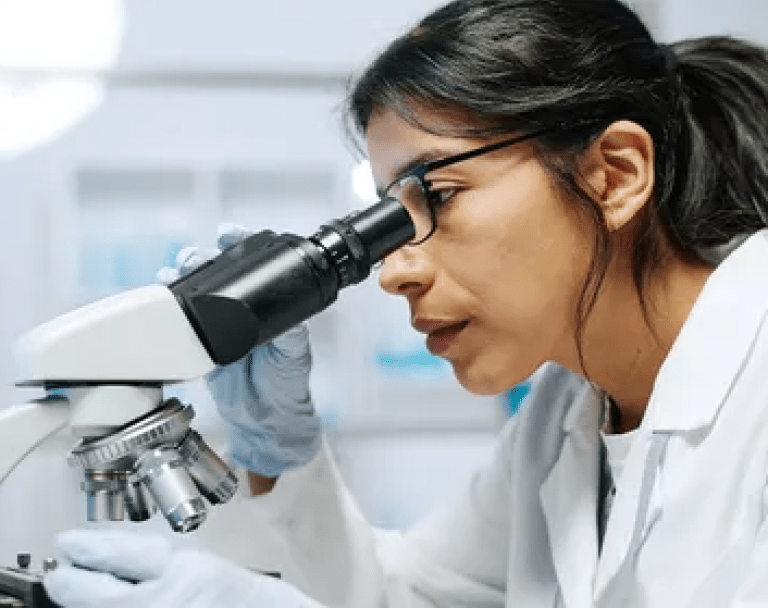At York College, students aren’t just reading textbooks and listening to lectures. They’re working on community projects, solving real-world problems, and using their education to effect change. In Designed for Action, we meet the students who are making an impact outside of the classroom.
Hyaluronic acid is a term that’s been tossed around within the skincare industry for some time, and Rachel O’Regan ’23 took notice of it.
“I have always been interested in skincare, and it was something I was passionate about,” the recent Chemistry grad says. “While watching TV one day, I kept noticing all these commercials that specifically mentioned hyaluronic acid in skincare. I had never seen it before, and now all of a sudden it is everywhere.”
According to WebMD, hyaluronic acid is a natural substance found in the fluids in the eyes and joints. It acts as a cushion and lubricant in the joints and other tissues, and different forms of it are used for cosmetic purposes.
In spring 2022, O’Regan was taking Chemistry Research 462, an experiential learning course required for all Chemistry majors. In the course, students are required to choose a specialized area of Chemistry to study. After noticing that there was little scholarly information on hyaluronic acid available to the public, as it is a newer product in the skincare market, she decided to specifically focus on finding its molecular weight in order to, she hoped, determine the ideal weight for it.
“If the molecular weight is too high, the hyaluronic acid will not penetrate deep enough in the skin to properly moisturize. If the molecular weight is too low, the hyaluronic acid will penetrate too far into the skin and may be the reason why some people have had reactions,” she explains. “I wanted to add to the discussion.”
Trials and tribulations
To determine the molecular weight of hyaluronic acid, O’Regan utilized a liquid-liquid extraction method, which proved to be challenging.
“In order to complete the extraction, the sample has to be a liquid, as the name suggests, and I was working with lotions and creams that are a solid/liquid mixture,” she explains. “I tried melting the lotions, centrifuging [using force to separate] them, and dissolving them in concentrated acid, and none of that worked to get the lotion to a liquid.”
What did work, she says, was switching to a serum.
“I decided to switch to a serum, which is a runny, almost liquid type of skincare, and that gave me much better results,” she says.
This allowed her to conduct a TLC (Thin Layer Chromatography) analysis, a specialized analysis technique that allows one to view the different compounds in a substance.
For the second part of her project, O’Regan needed to determine the prospective molecular weights of the hyaluronic acid. She used a MALDI-TOF instrument (Matrix-Assisted Laser Desorption/Ionization Time-of-Flight Mass Spectrometry) to do this. The MALDI-TOF is used to determine a sample’s mass—in O’Regan’s case, she used it for the molecules of hyaluronic acid. The sample was precise but not exact, she says.
“The method used on the MALDI-TOF was found to be precise, as the sample was run three times and I received very similar results. However, I was not able to determine whether the mass found was the actual molecular weight due to various complications that arose,” she explains.
Support through complications
Throughout her project, O’Regan was supported by her faculty mentor, Assistant Professor of Chemistry Dr. Kyle Howard.
“I enjoyed working with Dr Howard. He was always flexible with meeting times and always willing to help me whenever I had a question or issues that arose,” she says. “He also was always willing to chat about anything, even if it was not chemistry-related.”
She cites her education in Chemistry and previous coursework as helping her prepare for this project—specifically, her courses in Organic and Analytic Chemistry. She says those courses taught her how to “be patient and think through problems when they arise.”
“The Organic Chemistry and the Analytical Chemistry courses were the most beneficial. The Organic Chemistry course prepared me by teaching me how to complete TLC analysis and a liquid-liquid extraction,” she says. “The Analytical Chemistry courses taught me how to use the instrumentation and also taught me how to work through problems that arise when instruments don’t want to work or show results that may not be what was expected, and how to fix/deal with these problems that arise.”
Despite the challenges in her project, O’Regan still found the experience valuable.
“Although I did not get to answer everything I wanted to in my research, the experience was very valuable. It taught me that when things go wrong, as they inevitably will, you just have to keep trying and adjusting until you get results,” she says. “By going through the challenges, once you get results, the satisfaction is like nothing you will ever experience.”
She specifically cites a time when she found a mobile phase that worked on the TLC analysis.
“I was so proud of myself, and the feeling when I saw those spots show up under the UV light was beyond words. I don’t think I was ever that excited about something in my life,” she adds. “It made everything I worked for worth it. That feeling I got is my favorite part of the research process, and while I did not get all the answers I was hoping for, just making progress was good enough for me.”
O’Regan is currently pursuing a career in the chemistry field. Her preferred field is in the analytical area, but she’s keeping her options open, she says.
“I am open and flexible and willing to learn new things. I want to take every opportunity to better myself and learn as much as possible,” she adds.





